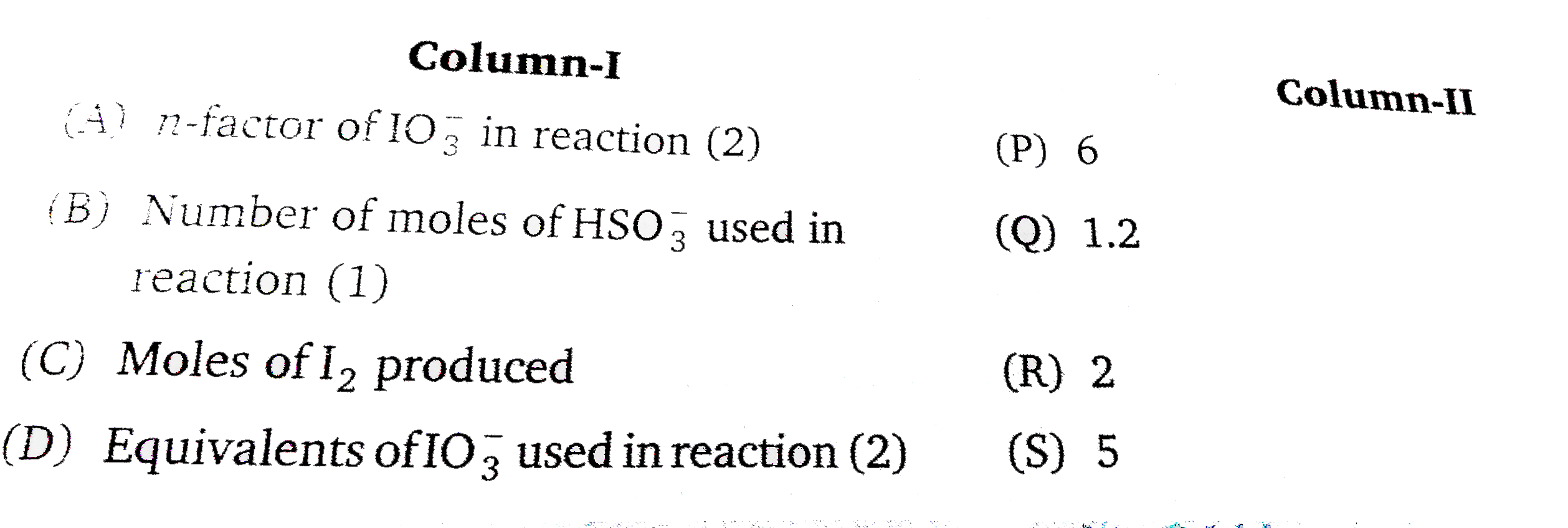IO−3+I−+H+→
To solve the reaction IO−3+I−+H+ and identify the products, we can follow these steps:
Step 1: Identify the Reactants
The reactants given are:
- Iodate ion IO−3
- Iodide ion I−
- Hydrogen ion H+
Step 2: Recognize the Type of Reaction
This reaction is characteristic of iodometric titration, where iodate ions react with iodide ions in an acidic medium to produce iodine.
Step 3: Write the Unbalanced Reaction
The unbalanced reaction can be written as:
IO−3+I−+H+→I2+H2O
Step 4: Balance the Reaction
To balance the reaction, we need to ensure that the number of atoms of each element is the same on both sides.
1. Count the Iodine Atoms:
- On the left side: 1 (from IO−3) + 1 (from I−) = 2 iodine atoms.
- On the right side: 2 iodine atoms (from I2).
2. Balance the Oxygen Atoms:
- On the left side: 3 oxygen atoms (from IO−3).
- On the right side: 1 oxygen atom (from H2O).
- To balance, we need 3 water molecules on the right side:
IO−3+I−+H+→I2+3H2O
3. Balance the Hydrogen Atoms:
- Now, we have 6 hydrogen atoms on the right (from 3 H2O).
- Therefore, we need 6 H+ ions on the left:
IO−3+I−+6H+→I2+3H2O
4. Final Balanced Equation:
The final balanced equation is:
IO−3+5I−+6H+→3I2+3H2O
Conclusion
The products of the reaction IO−3+I−+H+ are I2 (iodine) and H2O (water).
The reactants given are:
- Iodate ion IO−3
- Iodide ion I−
- Hydrogen ion H+
This reaction is characteristic of iodometric titration, where iodate ions react with iodide ions in an acidic medium to produce iodine.
The unbalanced reaction can be written as:
IO−3+I−+H+→I2+H2O
To balance the reaction, we need to ensure that the number of atoms of each element is the same on both sides.
- On the left side: 1 (from IO−3) + 1 (from I−) = 2 iodine atoms.
- On the right side: 2 iodine atoms (from I2).
- On the left side: 3 oxygen atoms (from IO−3).
- On the right side: 1 oxygen atom (from H2O).
- To balance, we need 3 water molecules on the right side:
IO−3+I−+H+→I2+3H2O
- Now, we have 6 hydrogen atoms on the right (from 3 H2O).
- Therefore, we need 6 H+ ions on the left:
IO−3+I−+6H+→I2+3H2O
The final balanced equation is:
IO−3+5I−+6H+→3I2+3H2O
The products of the reaction IO−3+I−+H+ are I2 (iodine) and H2O (water).
Topper's Solved these Questions
- THE P-BLOCK ELEMENTS BOOK - DINESH PUBLICATIONCHAPTER - THE P-BLOCK ELEMENTS EXERCISE - N.C.E.R.T. Exemplar Problems
27 Videos
- THE P-BLOCK ELEMENTS BOOK - DINESH PUBLICATIONCHAPTER - THE P-BLOCK ELEMENTS EXERCISE - Multiple Choice Questions
10 Videos
- THE P-BLOCK ELEMENTS BOOK - DINESH PUBLICATIONCHAPTER - THE P-BLOCK ELEMENTS EXERCISE - Problems For Practice
54 Videos
- THE OXYGEN FAMILYBOOK - DINESH PUBLICATIONCHAPTER - THE OXYGEN FAMILYEXERCISE - PREPARATORY PACKAGE
14 Videos
Similar Questions
Calculate the mole coefficient of H+ in the balanced equation.
IO−3+I−+H+OH−−−→I2+H2O.
View SolutionA sample of raw material contain NaNO3. It contains some NaIO3 also. The NaIO3 can be used as a source of iodine, produced in the following reactions:
IO−3+HSO−3→I−+SO−4...................(1)
I−+IO−3→I2+H2O............(2)
One litre of sample solution containing 396 g NaIO3 is treated with stoichiometric quantity of NaHSO3. Now a substantial amount of solution is added to reaction mixture to bring about the reaction (2).

View Solution
Knowledge Check
Which of the following conversions can be carried out by both acidified K2Cr2O4 and acidified KMnO4?
(i) Fe2→Fe3++e−
(ii) I−→IO−3
(iii) I−→I2
(iv) H2S→SA(i) and (iii)B(ii) and (iv)C(i),(iii) and (iv)D(i), (ii) and (iii)The coefficients of I−,IO−3 and H+ in the balanced redox reaction,I−+IO−3+H+→I2+H2O−, are respectively
A5,1,6B1,5,6C6,1,5D5,6,1NalO3 reacts with NaHSO3 according to eaquation Io−3+3HSO−3→I−+3H+3SO2−4The weight of NaHSO3 required to react with 100 mL of solution containing 0.58 gm of is :
A5.2gmB4.57gmC2.3gmDNone of the above
Cr(OH)3+IO3+OH−=I−+CrO2−4+H2O
View SolutionIO−3+N2H4+HCl=N2+ICl−2=N2ICl−2+H2O
View SolutionIO−3,IO−4,KI और I2 में आयोडीन की ऑक्सीकरण संख्या क्रमश: हैं
View SolutionOxidation number if iodine in IO−3,IO−4,KIandI2 respectively are
View SolutionOxidation number if iodine in IO−3,IO−4,KIandI2 respectively are
View Solution
